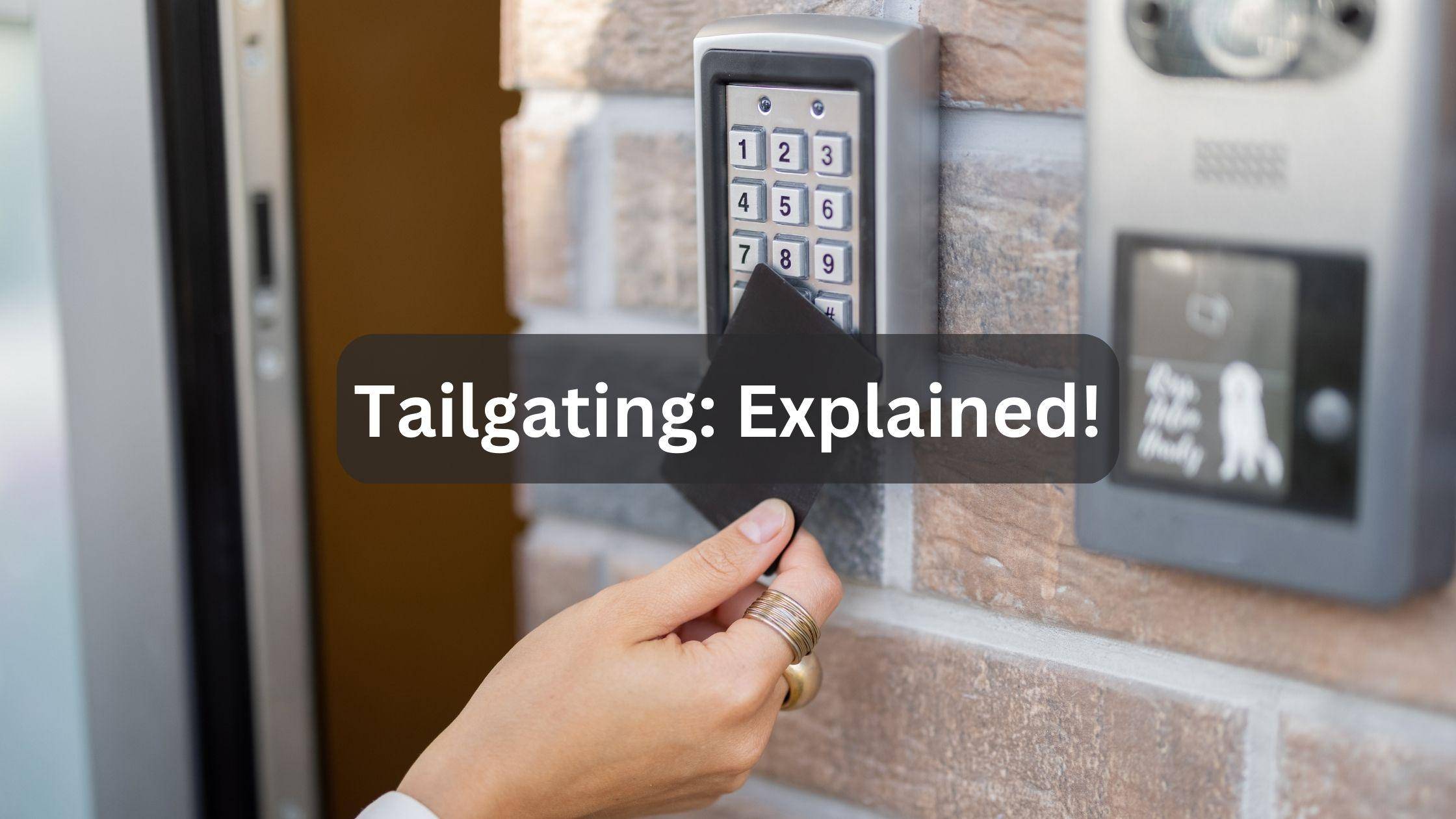Table of Contents
ToggleWhat is tailgating in cyber security?
What is tailgating?
Tailgating is a type of cyber attack where an unauthorised person follows an authorised person into a controlled area, such as an office building or an airport. It’s also a common method of entry used by cybercriminals to gain unauthorised access to restricted areas, such as data centres or other restricted areas.
The unauthorised person uses their access to enter the facility and then seeks to steal information or otherwise commit crimes. In this article we will discuss what tailgating is in cyber security, how it works, how to avoid becoming a victim, and what steps you can take to prevent security breaches from happening in your Organisation.
When and how does tailgating take place?
Tailgating is when a person follows you into a crowded place, such as an airport or train station. When you are in a crowded place, the person may try to get through the door or gate with you without having their own ticket or pass.
Tailgating can also take place when a person tries to follow you into areas that they do not have access to and do not belong in. For example, this could happen when someone gets into an area where there are only employees working and tries to walk around like they belong there. They may be trying to get access to sensitive information by walking around with employees who have access credentials for the secure area of your building.
Tailgating can be a problem because it allows people to get into places that they should not have access to, which could lead to stolen property or information. It is also important for companies and organisations to educate their Employees about this type of security breach so that they do not become victims themselves.
What dangers are there during tailgating?
The dangers of tailgating are extensive. The most obvious risk is that of data theft, but tailgating can also lead to physical theft, identity theft and network intrusion.
- Data Theft: Tailing individuals who have access to sensitive information can help cybercriminals gain access themselves. This could be done by following the individual into an office or facility containing valuable information that they shouldn’t have access to (such as a military base) and then copying the data or stealing it outright.
- Physical Theft: Criminals will often use tailgating tactics when carrying out actual crimes such as robbery or burglary.
- Identity Theft: Through observation and deduction, criminals may be able to determine personal details about someone based on the way they walk or talk or even how they dress, which can then be used in identity-related crimes such as credit card fraud or other types of fraud involving Social Security Numbers [SSNs].
- Network Intrusion: If an attacker has gained physical access through tailgating techniques, he/she may also gain access to a company’s computer network via physical ports such as USB drives if needed; this could give them full control over computers inside the building which means complete control over all systems connected within that Organisation including all servers running critical applications like email servers, payroll systems, etc!
What remedies stop tailgating?
- Use a badge reader: Your employees are issued a badge with an electronic chip. When someone presents their badge in front of the reader, it checks to see if that person is on your authorised list. The reader can also be set up to only allow certain people access through certain doors, such as by checking to see if they’re wearing clothing appropriate for their job title and department.
- Use a doorbell or buzzer system: When an employee arrives at the door, he presses the button outside—perhaps on his phone—and that triggers an alert inside so that someone can open up for him or her right away instead of waiting around until someone happens to walk past and notice them there waiting awkwardly by themselves looking like they’re doing something illegal like tailgating (but we all know they’re not because they’ve been given explicit instructions on how not to).
- Deploy surveillance cameras everywhere: Because everyone knows what happens when you don’t have enough eyes watching over potential targets: they get attacked! So make sure you always have somebody keeping watch over every inch of space available before allowing anyone else access into any area where valuable assets might be stored…or maybe just keep those assets locked away altogether so nobody gets hurt. That’s safer than letting employees wander around freely within striking distance from one another.
Detection of tailgating (piggybacking)
Using CCTV Cameras: The CCTV camera will capture the faces of the people who have entered the premises, so that you can identify them later if any crime is committed. There are other ways to detect tailgating, including using electronic access control systems. These systems are more expensive than CCTV cameras, but they are also more effective because they can be set up to prevent people from entering if their credentials do not match those on record.
Using Security Guards: Security Guards are an effective way to prevent tailgating because they know the people who work at the facility, and they can help to identify suspicious activity. If you have security guards on staff, then it is important that they are properly trained in preventing tailgating.
Why Is ‘Tailgating’ Important?
Tailgating is a type of cyber attack where the attacker gains access to a secured area by following an authorised person through the security checkpoint. This is a form of social engineering attack, which relies on human behaviour rather than technology to gain access to sensitive systems.
In order for tailgating to be effective, it needs two people: one person who has access and one who doesn’t. For example, someone may have left their ID badge at home or forgotten it at work—so they ask you for help getting inside so that they can retrieve it! Or perhaps you’re attending an event where employees are required to wear badges and uniforms; if you forget yours, your friend offers theirs because there’s still works fine (and looks similar enough). The bad guy takes advantage of this situation by walking into the building or facility with you as though they belong there too—you were already vetted by security so there’s no need for them too.
Tailgating is one of the easiest ways for bad guys to gain access to a building or facility. It’s also one of the most common ways that criminals gain access by taking advantage of an employee’s good nature and willingness to help out a coworker in need! When employees are aware of this vulnerability, they can better protect themselves when an imposter tries to walk in behind them.
Tailgating Or Piggybacking Attack: Ways To Avoid Becoming A Victim
There are a few ways to avoid becoming a victim of tailgating.
- Use a badge holder. You don’t have to go out and buy one, just get one from your local office supply store. This will make it harder for someone, like an intruder or thief, to get into your office building because they won’t be able to easily see which badge you’re wearing and sneak in behind you.
- Use a security guard or security camera system at the entrance of your building (or both). These can help deter would-be intruders from trying their luck with getting past them.
- If there’s nothing else that seems like it would work on its own then consider using all three methods together: use a badge holder; bring along a security guard during peak times when most people are leaving work; and/or add some extra layers of protection by installing more cameras around the building so that no matter where someone tries sneaking in through they’ll still be caught red handed!
Conclusion
At the end of the day, it’s important to be aware of the risks associated with tailgating and how you can protect yourself. Tailgating relies on human to human interaction to be successful. Hence, it is important that employees are aware of the risks of such cyber attacks and how to protect themselves from becoming a victim of a tailgating attack.
FAQs:
What is an example of a tailgating attack?
A good example of a tailgating attack would be sneaking into a building by walking right behind an authorised person without them knowing. This can often be done if you have access to their security badge, which means they don’t have to swipe in every time they enter and exit the building.
How do you prevent tailgating?
Some companies have a policy that requires their employees to swipe in and out of the building every time they enter or exit. This will help prevent someone from sneaking behind them without being noticed. Another way is to require that your security badge has a tamper-proof seal, which means if someone tries to remove it from your clothing, it will break apart and alert security.
Another good way to prevent tailgating is to have a security guard at the door who checks the identification badge of everyone entering and exiting the building. You could also add additional security measures like fingerprint or eye scanning, but that can be expensive.





